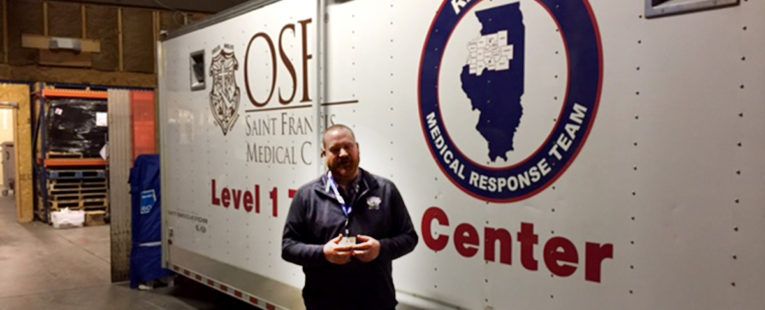In a hidden corner of Bartonville sits a warehouse stuffed to the gills with medical equipment big and small. Defibrillators, ventilators, durable medical goods, generators, equipment to refill oxygen tanks in the field, large mobile trauma center trailers, a 100-bed mobile patient collection center, HVAC units, trucks and much, much more crowd each other from wall to wall.
But why? How could anybody possibly use all that equipment?
For Troy Erbentraut, manager of the OSF HealthCare Saint Francis Medical Center disaster preparedness team, the hope is that nobody ever has to use it. For everybody else, it’s good to know that Erbentraut’s team, and all that equipment, are at the ready should it ever be needed.
“It’s better to have the equipment and the plans for a disaster, and not need them, than to need them and not have them,” Erbentraut said.
It may look like chaos to a casual observer, but the disaster preparedness team knows where every piece of equipment is, what it does, and how and when it should ever be deployed.
Ready for anything
These supplies are ready to respond to crises at any of the 25 hospitals in the 18 counties that make up the Illinois Department of Public Health (IDPH) Emergency Medical Services Region Two. OSF HealthCare Saint Francis serves as the Regional Hospital Coordination Center (RHCC) for the region, which extends from Livingston, McLean and LaSalle counties in the east to Rock Island, Mercer and Henderson counties along the state’s border in the west. The region includes OSF HealthCare facilities in Monmouth, Galesburg, Bloomington, Mendota, Ottawa, Streator, Pontiac and Kewanee.
This shared model decreases the strain on each hospital’s space, staff and supplies, while also making sure no hospital in the region falls short when its community needs care the most.
Should any hospital call him in need of help dealing with a crisis – tornado, flood, terrorist attack, anything – Erbentraut and his team can deploy whatever supplies are needed to wherever they are needed. He and his team also coordinate the 70-person Region Two Medical Emergency Response Team (RMERT), consisting of medical professionals from multiple disciplines ready to deploy to a disaster.
The disaster response model assembled by the OSF HealthCare Saint Francis team is designed to avoid what Erbentraut calls the “ripple effect.” If one hospital faces a disaster and cannot accommodate all of its patients, then the overflow patients will go to the nearest hospital and overwhelm that hospital, too. And so on, causing the crisis to spread.
“Let’s help out a hospital at its facility so they don’t have to transfer patients to another facility,” Erbentraut said. “Let’s put the fire out, not just push it around from one hospital to another.”
The OSF HealthCare Saint Francis disaster preparedness team also serves as a funnel for information during a crisis. The office provides a single point of contact for everybody from the local, state and federal levels so all parties can be sure their message gets where it needs to go.
Last Updated: February 10, 2022
